Operation Rheinübung and the sinking of Bismarck
In May 1941, most of Europe was ruled by Nazist Germany. The wolf packs of the Kriegsmarine ( German Navy ) inflicted heavy losses on British convoys and attacked the German battle cruisers Scharnhorst and Gneisenau ( Operation Berlin ), which sank or captured 22 ships with a total tonnage of 115,622 GRT, still weighing on the British Empire. At that time, a plan was born in the minds of German planners, involving 4 large surface ships - Bismarck and Tirpitz , moored in German ports, and Scharnhorst and Gneisenau , which have been moored in Brest since March 22. However, various circumstances stood in the way, due to which it was not possible to follow the original plan.
In Brest anchor Scharnhorst and Gneisenau were targeted raid Coastal Command (Coastal Command). Gneisenau was hit by a torpedo from a K. Campbell plane, which was mortally wounded in the raid and was posthumously awarded the Victoria Cross for his heroic deed. The damage to Gneisenau was so severe that it was not possible to set sail any time soon. In addition, Scharnhorst needed several months of machine repairs, so both ships dropped out of the action.
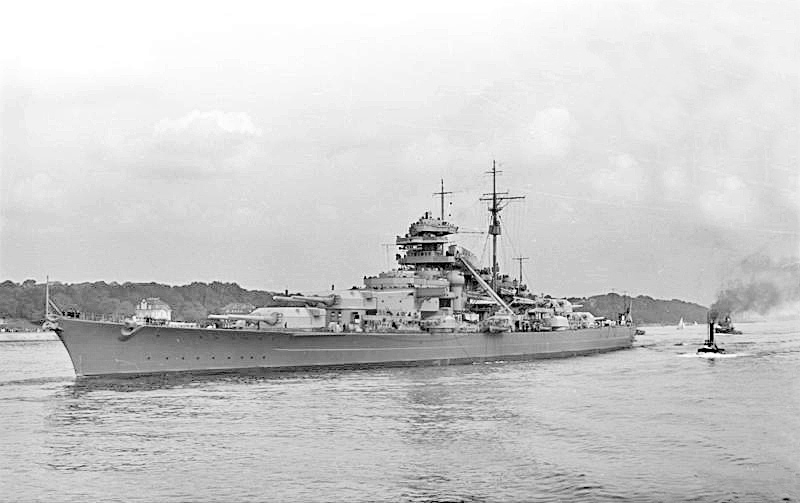
Bismarck in 1940
commons.wikimedia.org
Meanwhile, Bismarck and Tirpitz completed several months of exercise in the Baltic. Bismarck had the exercises behind him, but Tirpitz, who was launched a little later, was still rehearsing. Therefore, the heavy cruiser Prinz Eugen , also one of the new Kriegsmarine ornaments, was chosen as an alternative. So it was decided - only Bismarck and Prinz Eugen would be involved.
Bismarck , at one time the largest ship, was launched on 14 February 1939, its keel was established in September 1936. Entered service on September 24, 1940. It had respectable armament and armor, the main armament consisted of 8 cannons caliber 380 mm located in 4 towers ( 2 on the bow and 2 on the stern ) and named Anton and Bruno ( bow ) and Caesar and Dora ( stern ). The armament of medium caliber consisted of 12 guns caliber 150 mm, Bismarck was armed with 14 guns caliber 105 mm. The anti-aircraft defense was taken care of by 16 cannons caliber 37 mm and 38 cannons caliber 20 mm, which was not, as it turned out, sufficient ( for all ships during the war, the means of anti-aircraft defense expanded ). The hull of Bismarck was 251 m long and at its widest point was 36 m. The hull was built according to the old model from the 1st st. war, because Germany did not have time to develop better. The hull had insufficient armor for fuel tanks and equipment to control the ship. Wotan steel named after the Old Germanic god of war was used in Bismarck. It was further divided into types:
Wotan hart - armored steel that was used on the armor decks,
Wotan weich - armored steel that was used for anti - torpedo lining and
Krupp cemmentite steel - a special steel that contained 3.5 - 3.8% nickel, 2% chromium, 0.3% carbon, 0.3% manganese and 0.2% molybdenum. It was used on the side armor belt, towers and command tower.
The main armor consisted of a belt 170 m long and its thickness was 320 mm. Thanks to the use of special steels, the Bismarck was the ship with the largest armor of the time.The drive was provided by 3 turbines ( Blohm & Voss ), which had an output of up to 150 170 HP and were able to develop a maximum speed of 30.8 knots. Bismarck had 3 propellers. The range of the ship was 4,500 nautical miles at a speed of 28 knots, the maximum content of the tanks was 7,400 m 3 . Bismarck had a catapult for floatplanes. Up to four Arado AR-196 aircraft could be stored on board.
The first and last voyage of Bismarck
Bismarck and Prinz Eugen, under the command of Admiral Günther Lütjens, left Gotenhafen (now Gdynia ) on May 18, 1941 and passed through the Danish Straits of Kattegat and Skagerrak. In order to hide the corsair voyage to the British, the Germans organized a theater in the Baltic in the form of a large convoy with strong security ( Bismarck, Prinz Eugen, destroyers, etc. ). The air force patrolled over the floating convoy to, if necessary. neutralized reconnaissance aircraft. However, Bismarck was spotted by the Swedish cruiser Gotland and workers of the Norwegian resistance movement. Thanks to the contacts of the British attaché to us. chap. H. Denhem's news of the discovery of the convoy, which is accompanied by two heavy ships and destroyers, reached the west.
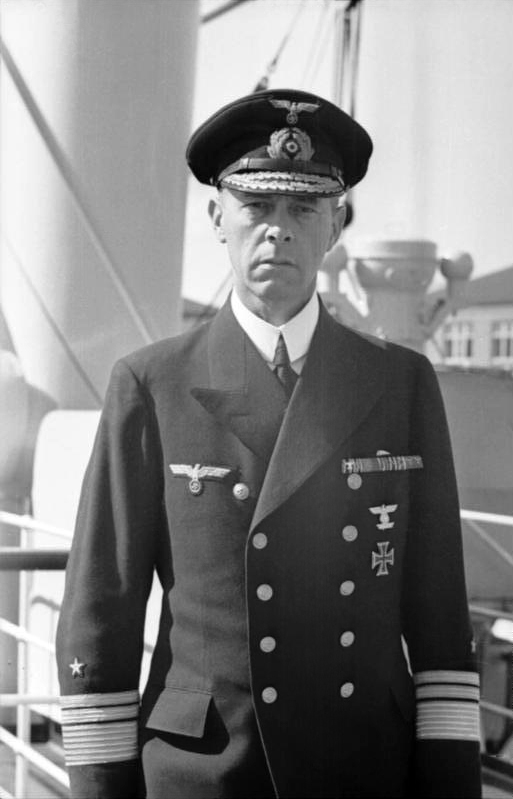
Günther Lütjens in April 1940
commons.wikimedia.org
The British were immediately frightened because they knew that Bismarck had been put into active service and that Tirpitz would be waiting soon. If Bismarck and Prinz Eugen got into the Atlantic, it would be a catastrophe of the greatest extent. Britain was on the defensive, important military convoys sailing across the Atlantic with reinforcements to the Far East. The British therefore immediately took steps to find both ships and determine what type they were. That day, Coastal Command reconnaissance aircraft explored the southern part of the Norwegian coast.
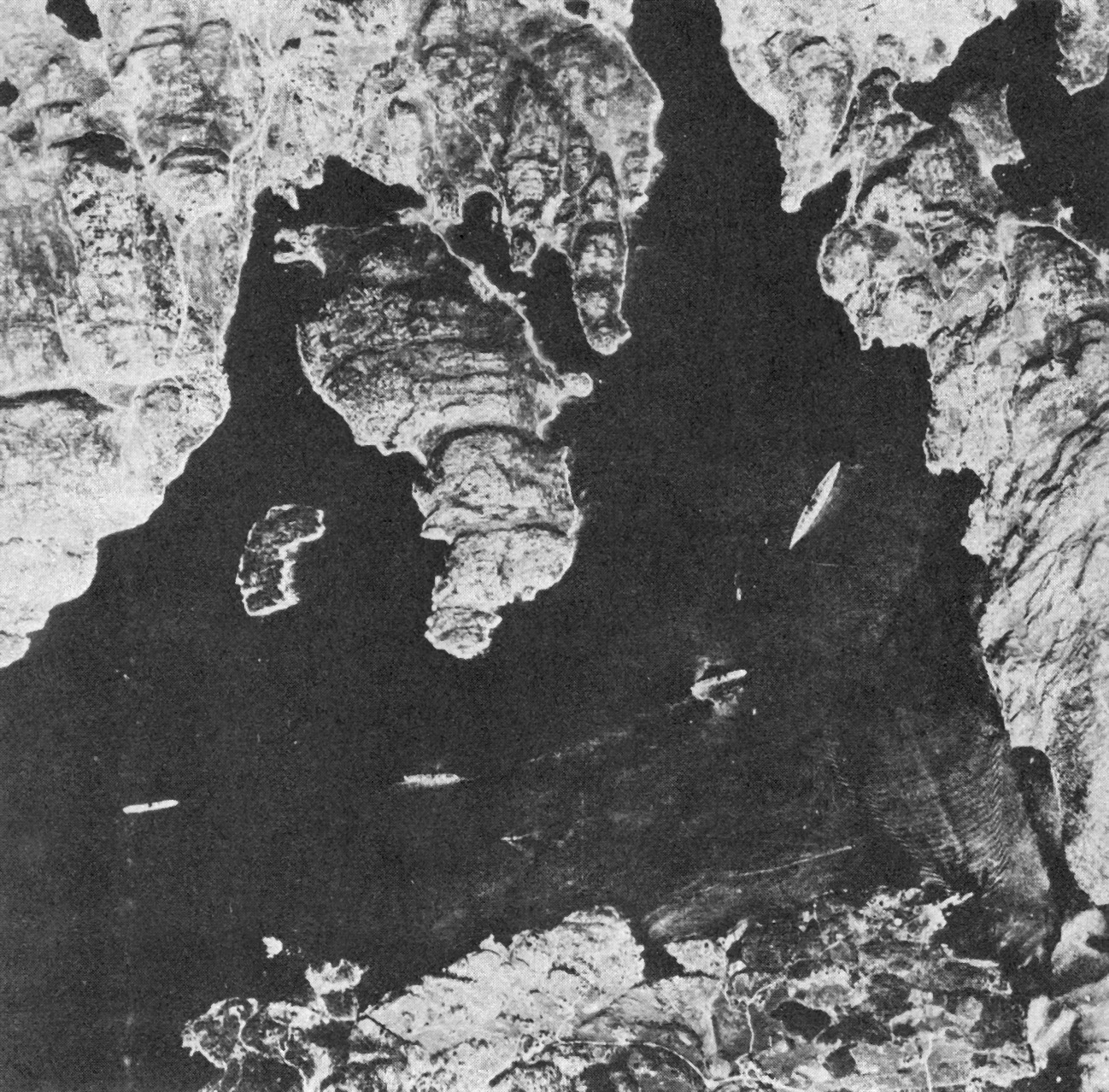
Photograph of Bismarck anchored in the Grimstafjord near Bergen on May 21, 1941
commons.wikimedia.org
A reconnaissance spitfire photographed both the ship and the tanker in the fjords near Bergen, Norway. Here Prinz Eugen replenished his fuel supply, but Bismarck did not do so! Admiral Tovey - commander of the British Home Fleet - therefore immediately reinforced patrols on the approaches to the Atlantic. The British were also warned that the number of reconnaissance flights over Scapa Flow towards the Danish Strait and into the strait between Iceland and the Faroe Islands had increased.
The main group of British warships was divided into two operational alliances: ( i ) Hood ( Cap. Ralph Kerr ) and Prince of Wales ( Cap. John Catterall Leach ) under Vice Admiral Lancelot Ernest Holland and ( ii ) King George V. and the British cruiser Repulse sent by the Admiralty from Clyde under the command of Admiral Lord John Cronyn Tovey . Meanwhile, the weather in southern Norway has worsened.The German squadron raised anchor and sailed north. At 5 o'clock in the morning, the destroyers were under the command of Major. Lieutenant Schulze-Hinrichs sent to Trondheim . Bismarck and Prinz Eugen were left alone on the high seas, heading further north.
Admiral Tovey had more reconnaissance aircraft sent, but they found the berth at Bergen empty - it was certain that Bismarck had sailed. Lütjens planned to cross the Strait of Denmark, which he penetrated into the Atlantic a few months ago as part of Operation Berlin, which was narrowed by British minefields from Iceland and floating ice from Greenland. Thus, only a narrow part of the strait remained for penetration into the Atlantic.
At 11 p.m., Bismarck and Prinz Eugen were about 200 miles north of Iceland, and Tovey and his fleet sailed from Scapa Flow. Lütjens now turned southwest to the first section of the Danish Penetration. It was light all night in this latitude, but it was still foggy. At 4 o'clock in the morning, the squadron increased its speed to 27 knots. At 10 o'clock she began to hit the ice floe and reduced her speed to 24 knots. The squadron was approaching the most dangerous section of the voyage - a narrow strait that was not wider than 30-40 miles at this time of year. The ships again increased their speed to 27 knots. Late in the afternoon it began to clear, the icy peaks of the Greenland Mountains could be seen on the right, and a gray layer of fog still clung to the left. At 6:15 p.m., as Suffolk sailed southwest, a Class 1 sailor saw Bismarck - dark and massive, emerging from the starboard fog about 7 miles away. He immediately shouted, " Ship in the direction of green 140!" "At that moment, Prinz Eugen also emerged from the fog. “ Two ships in the direction of the green 140! "
Suffolk immediately came to life and an alarm was sounded. An order was immediately issued: “ Quite left and full force forward! "In a few minutes he got into the fog and began to broadcast a continuous stream of information about the movement of the enemy. Norfolk , 15 miles away, was floating in a foggy belt when he picked up a message from Suffolk. Norfolk captain Philips immediately increased his speed and sailed into the open waters. However, he exaggerated a bit, and as he emerged from the fog, he saw Bismarck, 6 miles away, floating directly against him. Norfolk turned sharply to the right, trying to hide behind a foggy screen. Bismarck's cannon spoke for the first time. Orange flashes and plumes of smoke could be seen from Norfolk. Bismarck fired a total of 5 salvos at Norfolk before Norfolk got into the fog. Some of the ships were framed, but there was no direct hit, shrapnel fell on board, but no one was injured.
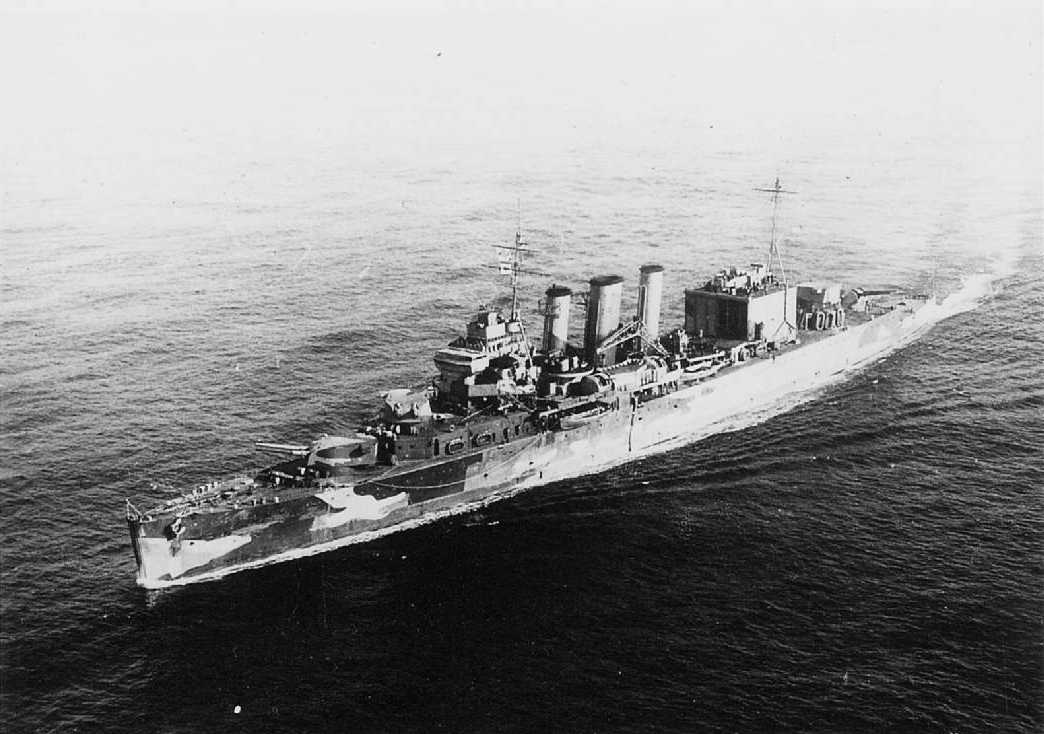
Suffolk, May 1941
commons.wikimedia.org
Suffolk continuously broadcast reports of enemy squadron movements. The first information was obtained from the ships and the coastal authorities of the Atlantic Command. At the same time that the optical signal from Norfolk was intercepted, Admiral Tovey was on his flagship King George V. about 600 miles to the southeast. The battleship Rodney , which sailed with four destroyers and the Britanic to Boston, also received information. The WS8B convoy ships, which had sailed from Clyde the day before and were carrying reinforcements to Suez, were informed. The information was also received by Vice Admiral Sir James Somerville, Commander of Fleet H anchored in Gibraltar .
The report was also intercepted by Bismarck and Prinz Eugen minutes after it was sent.But they mistakenly thought it was sent by King George V , not Norfolk . This important information was also captured by Vice Admiral Holland on Hood , who sailed with the Prince of Wales and destroyers just 300 miles from Bismarck. The mighty Hood embodied the power of the British Empire, was the oldest unit of the British navy. It was built in 1918 (the keel was founded in 1916 ) in the Clydes shipyards, its creator was John Brown, the author of the later series of transatlantic ships of the Queen series.
Hood was named after the famous family from which the four famous admirals arose. Lord Hood helped Rodney in the 18th century. to Defeat the French in the West Indies His brother Lord Bridport took part in the famous June 1, when Fleet Admiral Richard Howe defeated the French off the island of Uskant in 1794. Hood himself died near Jutland when his flagship Invincible was destroyed by an explosion. Horace Hood's widow performed the ceremonial baptism of the battleship Hood when it was launched in August 1918, three months before the armistice.
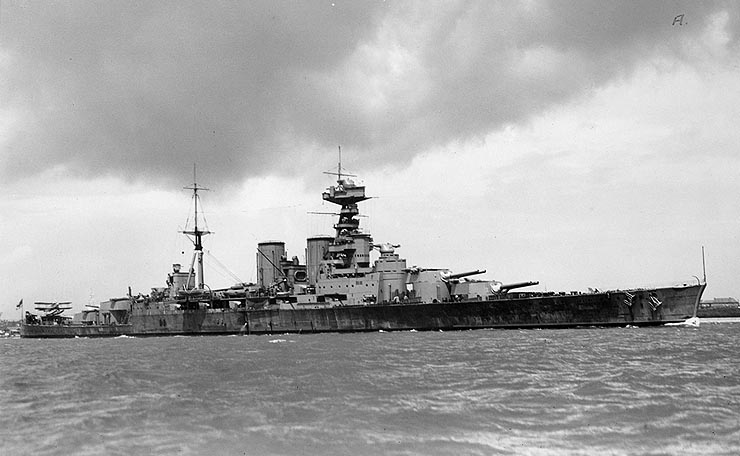
British battle cruiser Hood around 1932
commons.wikimedia.org
Hood was the largest ship ever built, longer than the Bismarck ( 262 vs. 252 meters ), but was slightly narrower, which did not provide him with such stability when firing. He had 8 cannons caliber 381 mm built in pairs into four towers. It reached a maximum speed of 32 knots, and was therefore the fastest ship of this size. Although he looked perfect at first glance, he had a huge weakness - the armor of the upper decks. It was designed before the Battle of Jutland, where three British battlecruisers were sunk by German grenades, which penetrated vertically lightly protected decks and exploded inside the ships. All ships built after the Battle of Jutland had reinforced armor. Hood's armor was reinforced on his sides, but not on the decks, which was fatal for him.
In the 1930s, the " ship defect " was to be eliminated, but its elimination for many months, when Mussolini and Hitler were already in power, was unthinkable. Therefore, only the most necessary equipment in the form of anti-aircraft guns was added. Now, after 26 years, he was ready to face the enemy on the high seas. Hood broke through the waves, followed by the Prince of Wales at the back, the destroyers Electra , Anthony , Echo , Icarus , Achates and Antelope in front. Four minutes after 8 a.m. on May 23, 1941, when Hood intercepted a signal from Suffolk, the admiral examined the map with staff officers, drawing the mutual position of Bismarck and the relative direction of the voyage to the Hood route.
He then sent a signal to the squadron to increase speed to 27 knots and sail in 295 degrees, destroyers that could not keep up with this speed, both ships were to follow as quickly as possible. Bismarck, firing at Norfolk, knocked out the front radar with a pressure wave of his own artillery, and therefore did not have a covered front section.Lütjens wanted to know what awaited him, so Prinz signaled Eugene to take the lead at the squadron. Bismarck reduced his speed by a few knots and Prinz Eugen got in front of him. This took place at a time when British cruisers had lost radar contact for a while, so they did not know that Bismarck was no longer sailing in front, but Prinz Eugen.
Now Prinz Eugen was first, Bismarck was second, and Suffolk and Norfolk were 14 miles behind them, all at 30 knots. Hours passed and four ships continued to move south. Fleet H, moored in Gibraltar , was ordered to set sail to protect the WS8B convoy as the Admiralty feared the Bismarck's penetration to the south. At 10 p.m., Hood and the Prince of Wales began preparing for battle. The squadron went on full combat readiness. Vickers Armstrong technicians were on standby in all the towers of the Prince of Wales in the event of a shooting fault. 12 minutes after midnight, Holland ordered the squadron to turn 45 degrees to the right and reduce speed to 25 knots, 15 minutes later Holland changed direction by another 15 degrees. Holland sent a signal to the entire squadron to raise battle flags. The first signal from Suffolk was sent at 00:28, and at about the same time Holland announced that if the enemy was seen by 2:10, it would turn south. He wanted him to stay ahead of Bismarck, even if he kept the southern course.
It was 1.5 hours without the enemy being seen, without a new report coming from Suffolk and Norfolk. Holland took a constant course of 200 degrees, ie to the southeast, the course that Bismarck sailed when the cruisers lost touch. Lütjens narrowly escaped him. The British ships sailed on almost the same route that the German ships could catch in, and were only 20 miles away when, at 1:45 a.m., the German ships changed direction somewhat west along the solid Greenland ice.
Admiral Holland's destroyers passed the Southwest by only 10 miles, and if visibility had not been reduced to 3-5 miles, they would almost certainly have been spotted. The men of Hod and Prince of Wales had been at the battlefields for over 4 hours. Just before 3 o'clock, Suffolk, sailing at 30 knots, signaled that he was in touch with the enemy again. An evaluation on Hood's map showed that Bismarck was about 35 miles to the northwest and that British ships were slightly ahead of him. For about an hour, both squadrons sailed on a deviating course - Lütjens in the direction of 220 degrees and Holland in the direction of 200 degrees. Therefore, the distance between them increased.
The Netherlands instructed the squadron to turn slightly inward, ie across the route of Bismarck and Prinz Eugene, and increase the speed to 25 knots as quickly as possible. It was clear that there would be a clash, but with Suffolk losing touch for a time and Bismarck changing course to the west, the situation for the British worsened considerably. The German ships were far ahead, and a fast forward approach, as planned by Holland, was not possible. The ships will approach at a wide angle, making them slower.
The situation worsened when Suffolk reported that Bismarck had made a slight change of course to the west, leaving the squadrons sailing in parallel. Hood can now be vulnerable for a long time to German grenades falling at a great angle. At 4 a.m., the enemy squadron was only 20 miles away, an hour later only 15 miles away. At 5:10 a.m., Holland ordered immediate preparation for action. When enemy ships were spotted, they were 17 miles away. Hood signaled the Prince of Wales to change direction 40 degrees to the right. Such a big change caused Hood and the Prince of Wales to approach at such an acute angle that their rear turrets would not be able to fire, but it also meant that Hood's vulnerable deck would be released to enemy fire for a minimum amount of time.
The crew of Bismarck and Prince Eugene spent a quieter night, not knowing about Hood and Prince of Wales's movements.At 5 o'clock the listening service on Bismarck found 2 fast-moving ships approaching from front to left. The bridge was ordered to check the report by the radar, but it did not record anything. The first optical evidence of the sighting of British ships was provided by a third artillery officer, who saw smoke far to the southeast. The German squadron had differing views on what ships are. In Bismarck, they thought they were two cruisers.
There was confusion among the British as well, as they did not know which ship was the Bismarck ( both ships had a very similar silhouette precisely because of the poorer recognition ). Holland, who thought Bismarck was sailing in front, signaled the Prince of Wales: " Prepare to open fire! Target the ship to the left! “The first grenades, cartridges and silk bags with refills were transported from the ammunition depots to the turrets of all four ships. The first grenades were already ready in the cannon chambers, the cannon's closures were closed and secured, and control bulbs confirmed that the cannons were ready to fire. Artillery officers Schneider (Bismarck ), Jasper ( Prinz Eugen ), McMullen ( Prince of Wales ) and Moultrie ( Hood ) were prepared on four ships.
The sinking of Hood
At 5:55, Hood fired his first volleys. A gong sounded on Hood announcing the start of the fight. There was a moment of silence, then a deafening blow and four missiles, each weighing a ton, flew out of Hod at 2,575 km / h ( 715 m / s ). At that moment, the Germans realized that they were not cruiser cannons, but battleships. When the first artillery officer, Lt. Capt. Adalbert Schneider, saw a flash of heavy artillery, he shouted, “ HOOD! That's Hood! "At that moment, the Prince of Wales called .
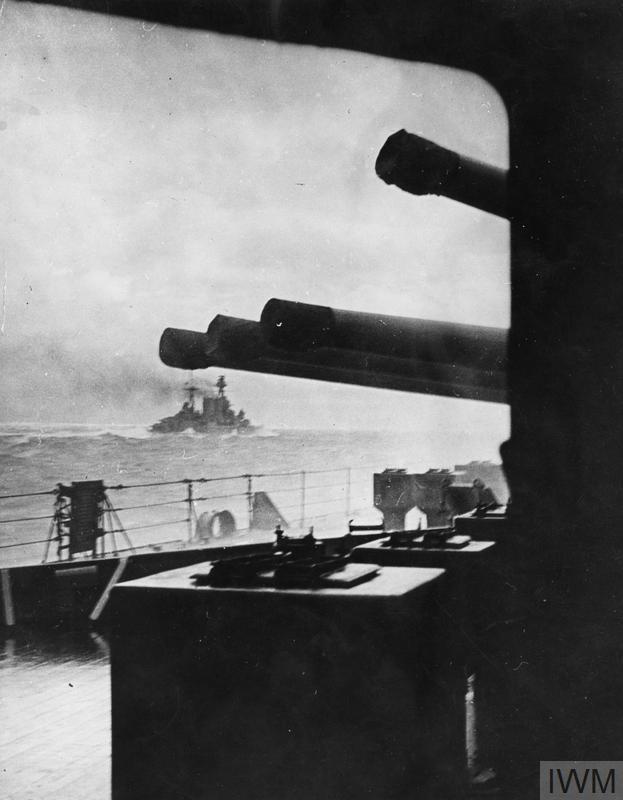
Last photo of Hood, view from Prince of Wales
commons.wikimedia.org
The Germans thought that the second battleship was King George V. and not the Prince of Wales, whom they did not even know had been put into service! Grenades flew here and there. Shots from Hod fell near Prinz Eugene , but did no damage. Missiles from the Prince of Wales landed 1,000 meters in front of Bismarck , missiles from Bismarck and Prinz Eugene landed dangerously close to Hod. Everything was now playing against the British, their original predominance of 18: 8 heavy artillery was reduced to 10: 8 and later to 9: 8, because one Prince of Wales cannon failed after the first volley.
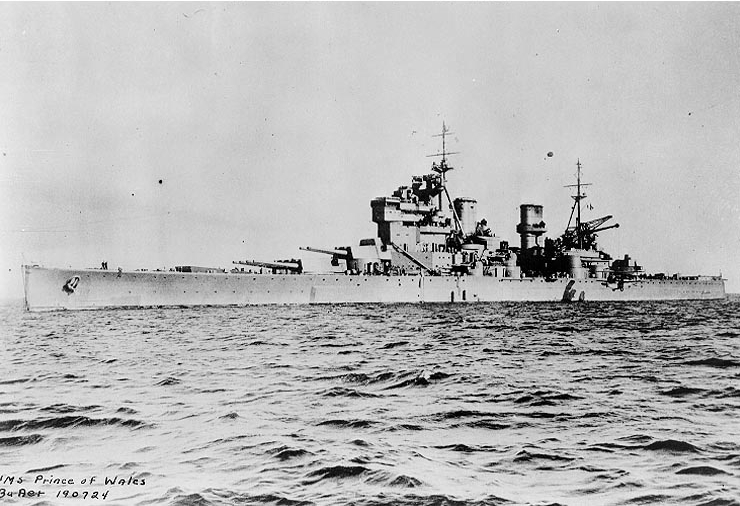
Prince of Wales in 1941
commons.wikimedia.org
The fighting continued and Hood was hit on the middle deck, where it was ignited by a flame, and an anti-aircraft ammunition depot was hit. Then Hood was hit again by another bullet and many crew members were killed and hidden in the hangar. Holland decided to make a small turn to the left so that half of his firepower would not remain out of action. The order was carried out and both ships began to turn. When Schneider saw a fire on Bodearck's deck, he ordered another volley. For the fifth time in 4 minutes, Hood was strewn with columns of water after grenades. However, one did not cause a column of water. It hit the ship ( at 6:01 ) perpendicularly exactly between the center and the stern, penetrated the thinly armored deck into the 102mm ammunition depot, where it caused an explosion, which was transferred to the rear depot of 381mm ammunition, where it again caused an explosion.A huge pillar of fire shot out of Hod before the eyes of all parties involved. According to one of the sailors in Norfolk, it was four times the size of the mainmast. A huge cloud of mushroom smoke rose from the fire. But the explosion was quiet. As the smoke cleared, Hood's hull was broken, broken in two, the bow and stern protruding into the sky. When Hood sank ( at 6:03 ), he buried Admiral Hollande, Captain Ralph Kerr, 90 officers and 1,400 men of the crew. Only three survived: Cadet Dundas, first-class sailor Tilburn, and liaison Briggs.
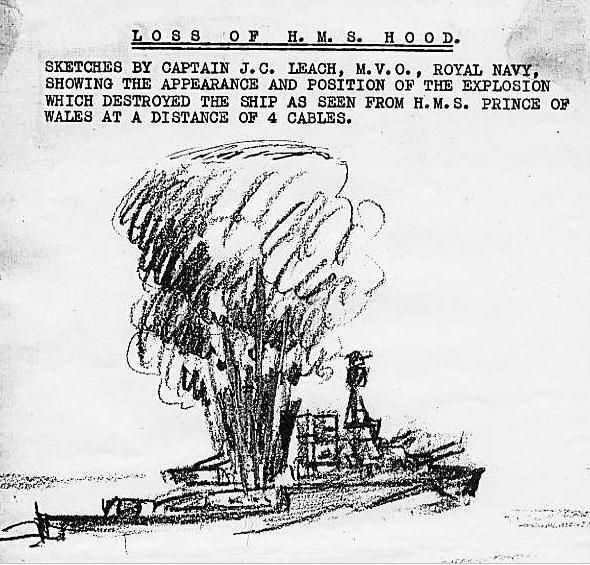
Hood during and after the explosion; a sketch prepared by Captain Leach ( Captain of the Prince of Wales ) for the Second Commission of Inquiry in 1941
commons.wikimedia.org
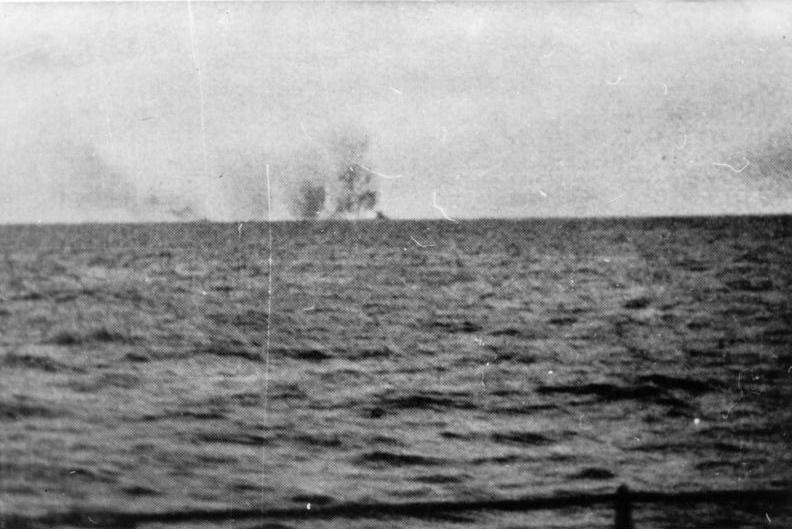
The end of Hood
commons.wikimedia.org
The Prince of Wales had to make a sharp turn to the right to avoid the wreck. Now both German ships have transferred fire to the Prince of Wales. The Prince of Wales has succeeded. The sixth volley framed Bismarck, but then a volley from Bismarck landed and chaos ensued. Everyone on the bridge was killed except Captain Leach and the liaison officer. The Prince of Wales was now within reach of the Prinz Eugene torpedoes, but just before the fire, the Prince of Wales turned and sailed away. No wonder, because in 12 minutes he was hit by four grenades from Bismarck and three from Prinz Eugene. One 380 mm grenade and two 203 mm grenades hit the ship under the waterline and 400 tons of water entered the ship. Another 203mm grenade penetrated into the ammunition preparation room, where it did not cause any damage. During the 9th and 13th volleys, the Bismarck was framed, but faults occurred in the newly installed works.
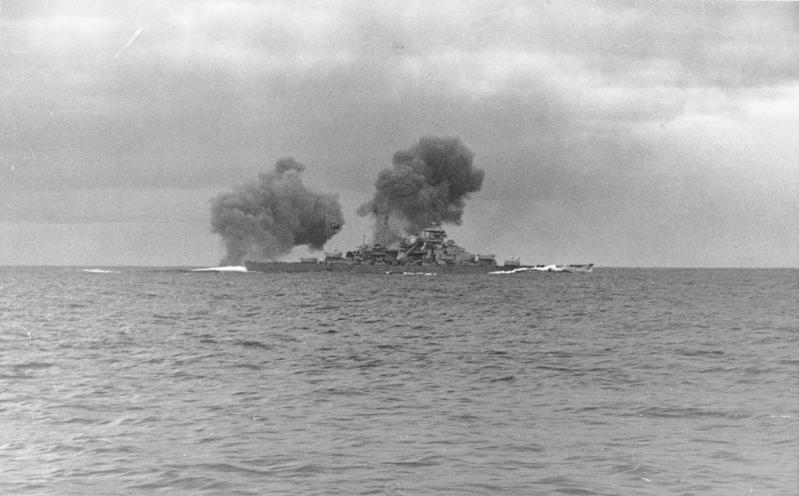
Cannons of Bismarck in action against the Prince of Wales after the sinking of Hood
commons.wikimedia.org
Captain Leach realized that if he continued to fight, he would deprive the British Empire of another valuable naval unit. His commander-in-chief, Admiral Tovey , was only 300 miles southeast of his union, so he decided to lay a smokescreen and flee the fight, join the cruisers, and then attack Admiral Tovey with his forces. Therefore, after firing the 18th salvo, the Prince of Wales created a smokescreen and sailed southeast. It was 6:09 o'clock. Admiral Wake-Walker sent a report of the sinking of Hod along with coordinates. Few in Britain could believe that Hood had been destroyed. When the men of Bismarck and Prinz Eugene learned that the sunken enemy ship was the famous Hood, they burst into excited cheers. Lütjens had the damage found immediately. No reports from Prinz Eugene were reported, Bismarck received 3 hits:
- the first grenade swept the captain's boat into the sea and damaged the catapult of the plane,
- the second grenade hit the center of the ship, penetrated the ship, smashed the dynamo, deactivated boiler room number 2 and two boilers and caused partial flooding of this section,
- the third grenade did the most damage - hitting Bismarck's port on the bow where the fuel tanks were located, piercing the second oil tank where water had entered, and damaging the intake valves, depriving Bismarck of a large amount of fuel.
Now it was obvious that Bismarck had not refueled in Norway.The partial flooding of the bow caused the ship to tilt 2-3 degrees forward and 9 degrees to the left, so that the right propeller found itself above the water. Therefore, it was ordered to flood the relevant parts of the stern to compensate for the tilt. The speed was limited to 28 knots. Lütjens had three options:
- could return by northern route to Norway or Germany,
- continue the voyage to the Atlantic, refuel there and continue the task,
- sail to one of the French ports, make repairs there and then continue to attack British convoys.
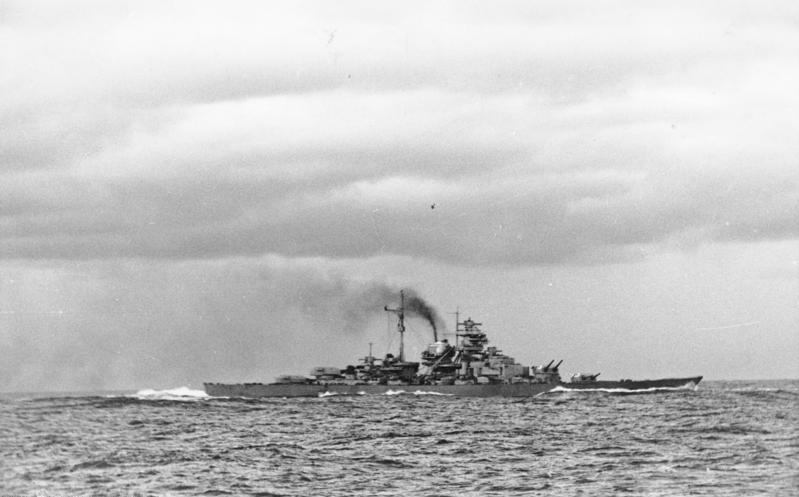
Bismarck photographed from the ship Prinz Eugen after the Battle of the Danish Strait
commons.wikimedia.org
On the British side, a large-scale action was launched to destroy Bismarck and Prinz Eugen . The old battleship Revenge sailed from Halifax, Nova Scotia, the battleship Ramillies sailed from the east coast of New Founland, the heavy cruisers London and Edinburgh from the Azores, and the battleship Rodney with destroyers from the Clyde. They were all tasked with destroying Bismarck and avenging Hood . Just 360 miles southeast of Bismarck was Admiral Tovey's fleet with the battleships King George V and Repulse , the aircraft carrier Victorious, and the cruisers.
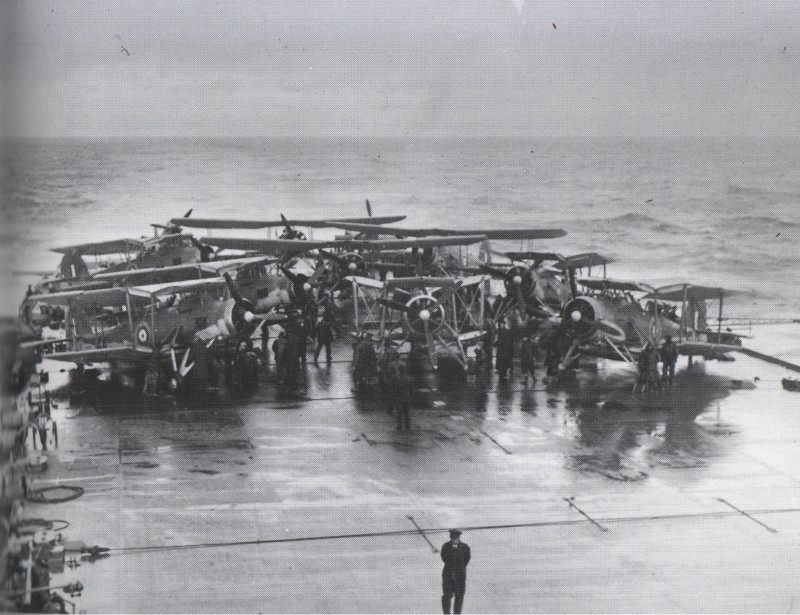
Swordfish torpedo bombers aboard the Victorious before the attack on Bismarck
commons.wikimedia.org
During the morning, Bismarck reduced his speed to 26, then to only 24 knots to allow repairs to the bow. Visibility deteriorated, Bismarck disappeared into the fog, and Suffolk lost radar contact. Wake-Walker suddenly had the impression that Bismarck had changed course to the left across the Norfolk route. He ordered Captain Philips to turn left 360 degrees, and only then did he continue in his original direction. 40 minutes later, as the fog cleared, Bismarck was only 8 miles ahead. He did change course 30 degrees to the left, if Wake-Walker had not ordered the circle to be written, Norfolk would be a mile or two away from Bismarck and Prinz Eugene, who would certainly not miss a chance to sink the British cruiser.
Visibility varied throughout the day, sometimes with Bismarck in sight, other times lost, but Suffolk re-established radar contact. Lütjens decided to send Prinz Eugene to an independent corsair activity and sailed to St. Nazaire . Between 6 and 7 p.m., Bismarck abruptly changed course toward British ships and fired several shots. Meanwhile, Prinz Eugen unnoticed escaped to the southeast.
Shortly after 3 a.m., Suffolk lost radar contact with Bismarck, but this time failed to restore it. Bismarck escaped after 32 hours of surveillance.This happened when Suffolk was moving away from Bismarck (the ships reached the waters in which German submarines were reported, and therefore had to sail on a " winding " course ). Bismarck circled a large circle and then headed for the Bay of Biscay. Tovey had to act very quickly and divide his forces to cover all possibilities for Bismarck's escape.
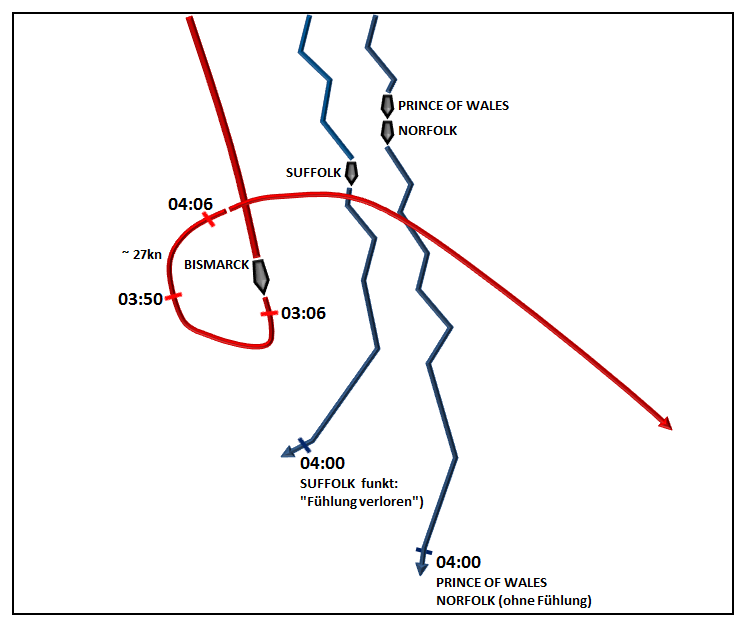
Bismarck's 3⁄4 turn on May 25, 1941. Lütjens' tactics were very successful and freed him from the pursuers.
commons.wikimedia.org
Wake-Walker's group changed course to the west, Suffolk and Norfolk split. The Prince of Wales sailed to Admiral Tovey's group. Admiral Tovey himself changed course to the southwest to cover the west wing. The second cruiser squadron, along with the aircraft carrier Victorious, stood in the way of a possible escape to the north. Around this time, Tovey was forced to send a battle cruiser Repulse to Newfoundland to refuel. The battleship Rodney with destroyers was also approaching the Bismarck hunting area.
By the time Suffolk lost radar contact, the battleship Ramillies was about 400 miles south of its last known position. So Captain Read changed course to be in the best position possible if Bismarck headed south to the Atlantic. At a time when the British were desperate because they did not know where Bismarck was, Lütjens was sending an extensive report to Major General Saalwächter, commander of the Paris-based naval group West, about the course of the battle in the Danish Strait and the effectiveness of British radar. The report was also intercepted by the British, but only in the British Isles and, unfortunately for them, not in Gibraltar or Iceland. This meant that the resulting lines on the maps were almost parallel and intersected in only two places: one focus was south of the last known position, the larger focus was north. Tovey and his staff assumed that the northern intersection ( 57 N, 33 W ) was correct, and therefore that Bismarck was heading north. Tovey regrouped the fleet again to block all access to the North Sea. Suffolk headed back to Iceland, the Prince of Wales to the Danish Strait, the 2nd Cruiser Squadron and the Victorious were to secure the area between Iceland and the Faroe Islands, and King George V headed north.
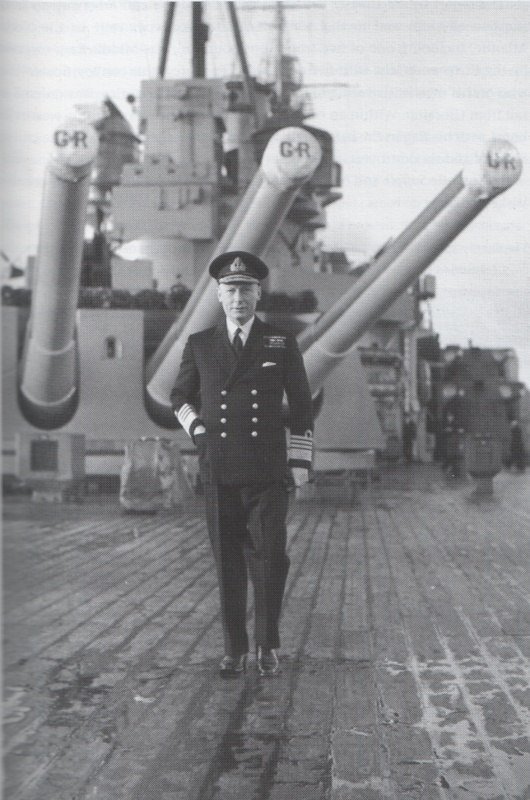
Sir John Tovey aboard the battleship King George V
commons.wikimedia.org
The navigation officer on King George V. re-entered the coordinates on the maps, made calculations, and found that the former were bad and that Bismarck was in the south, not the north, where the entire fleet was heading. After seven hours ( at 18:10 ) of sailing in the wrong direction, the fleet turned south again. Tovey had to send more ships to refuel. Suffolk, Vice Admiral Curtis' 2nd Cruiser Squadron, sailed for Iceland, and because the aircraft carrier Victorious could not be left unaccompanied, she sailed with them. A few hours before them, the Prince of Wales also headed for the harbor. So Tovey lost one battleship, one aircraft carrier, and five cruisers.
Tovey urgently needed ships to protect heavy ships from enemy submarines, so the 4th Destroyer Fleet was detached, escorting the WS8B convoy under Captain Philip Vian. It consisted of the ships Cossack , Maori , Zulu , Sikh and Polish Piorun .At two o'clock in the morning, the destroyers left the convoy and headed for Bismarck. Lütjens received a telegram informing him that the Air Force would protect him as soon as he reached their range, that a line of submarines was forming 300 miles west of Brest, and that destroyers would be sent to meet him. At the same time, Grand Admiral Raeder congratulated him on Lütjens's birthday on May 26.
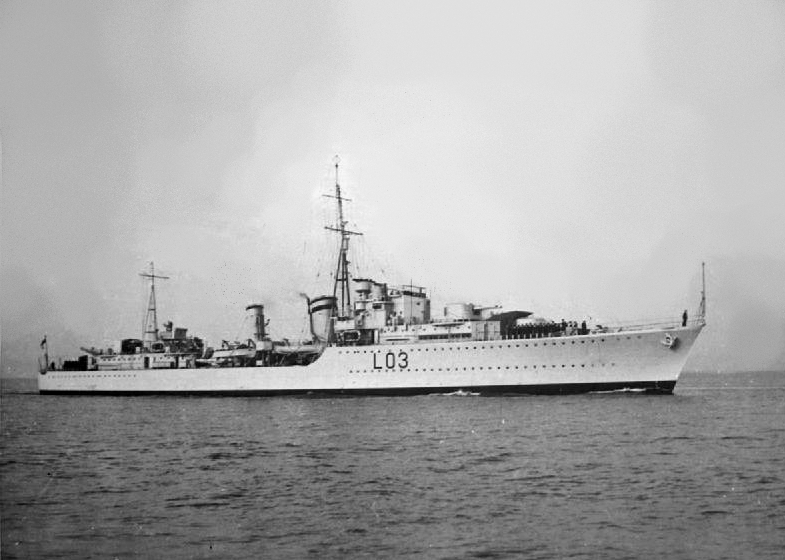
Destroyer Cossack, Captain Vian's flagship
commons.wikimedia.org
Now, Bismarck was best able to attack Ark Royal aircraft sailing with Union H of Gibraltar. In the morning, Bismarck was found by Catalan, who was sent from Northern Ireland. Half an hour later, a reconnaissance plane from Ark Royal found him, but he mistakenly identified him as a cruiser! Therefore, additional aircraft were sent to determine whether it was Bismarck or not. Tovey knew that if Bismarck sailed at just 20 knots, he would be under the protection of Luftwaffe planes taking off from French airports on the morning of May 27. So he had to slow down Bismarck's speed to 15 knots and face it by evening. There were only two ways to do this - Vian's destroyers and Ark Royal aircraft. In both cases it was a torpedo attack.
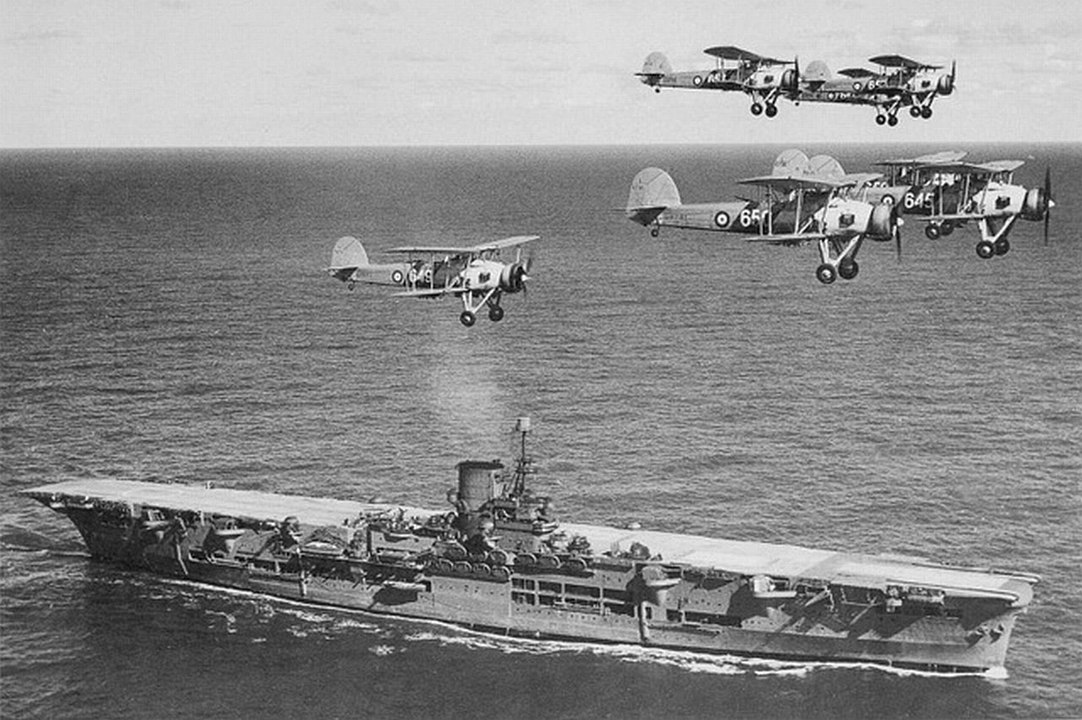
Aircraft carrier Ark Royal with a squadron of Swordfish bombers in the foreground
commons.wikimedia.org
At 2:30 p.m., planes took off from Ark Royal to attack Bismarck, but at 1:30 p.m., the light cruiser Sheffield sailed toward Bismarck to make optical contact with it. However, the pilots of the aircraft did not know this and were told that there was no British ship near Bismarck. Therefore, when the pilots reached the area where Bismarck was supposed to be, they attacked the first target they saw - Sheffield. Fortunately, not a single torpedo hit the target, and a defect in the magnetic torpedo detonators was discovered and replaced with a contact one for the next attack. Shortly before 6 p.m., Sheffield made contact with Bismarck.
At 19:19, aircraft from Ark Royal began to take off for the second attack on Bismarck. The planes got over Bismarck and he began to fight fiercely. He zigzagged to dodge the approaching torpedoes, but did not escape. When the rudders were in the extreme position, Bismarck was hit at the stern. He began to follow a large circle to the left. An order was given for the ship to return to its original course, but the answer came that the rudders were not responding.
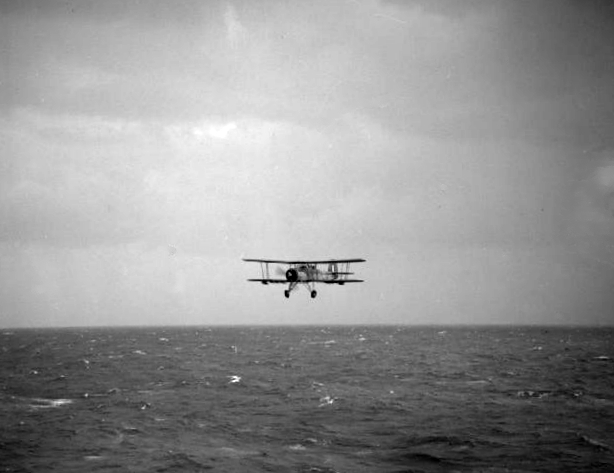
One of the Ark Royal Fairey Swordfish aircraft returning low over the sea from a torpedo attack on Bismarck
commons.wikimedia.org
Bismarck now sailed northwest directly into the arms of major British forces. At 9 p.m., the planes returned from the attack on Bismarck. The interrogation of the pilots revealed that Bismarck was hit by two torpedoes, one right in the center of the ship and the other from the right hitting the stern. It damaged the rudders or the propellers. Immediately after the attack, divers were lowered to the rudders to determine the extent of the damage. They returned with the unhappy news that the rudder control mechanism was crossed. Lütjens immediately promised the Iron Cross to someone who would repair the ship's damaged controls.But no one could.
Now it was Viano's destroyer to follow Bismarck. At 22:37, a patrol on Piorun reported contact with Bismarck, who immediately opened fire, but the destroyer did not intervene. Now the destroyers were stationed in a square around the wounded Bismarck, the flagship Cossack sailing behind Bismarck. The destroyers attacked at night and some Bismarck torpedoes apparently hit. It just so happened that none of the destroyers were sunk, although the Germans had a very good line of sight. The Polish Piorun had to turn around and sail into port because he was running low on fuel.
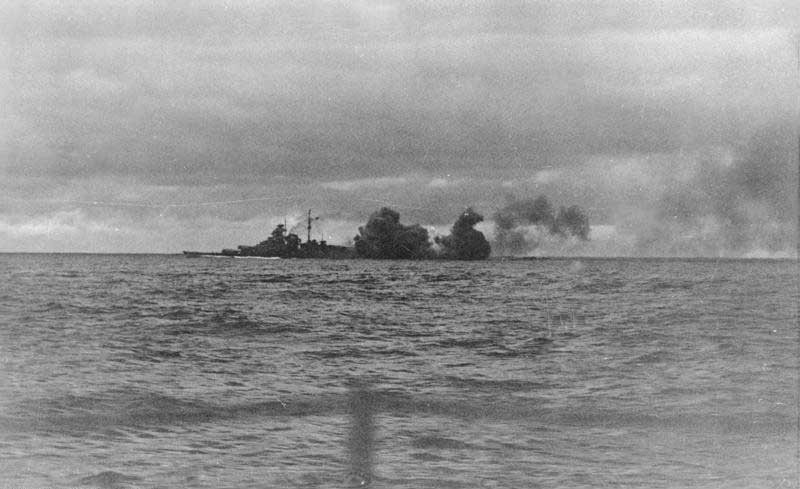
Bismarck's fire from the main battery during the battle
commons.wikimedia.org
Lütjens called the corvette captain Schneider on the bridge and handed him the Knight's Cross , which had been awarded to him by Hitler for sinking Hood. Lütjens already knew his fate, so he tried to save the ship's log. The ship contained Luftwaffe officers and Arado aircraft to transport the logbook to France. However, when attempting to take off, it turned out that the take-off mechanism was damaged, so the aircraft could not take off. At 7:10, Bismarck sent a telegram to let the submarine sail to save the logbook. However, the submarine did not appear. At 8:43, King George V and Rodney Bismarck were in sight. Lütjens knew it was over, so he had the food stores open so that everyone could take what they liked.
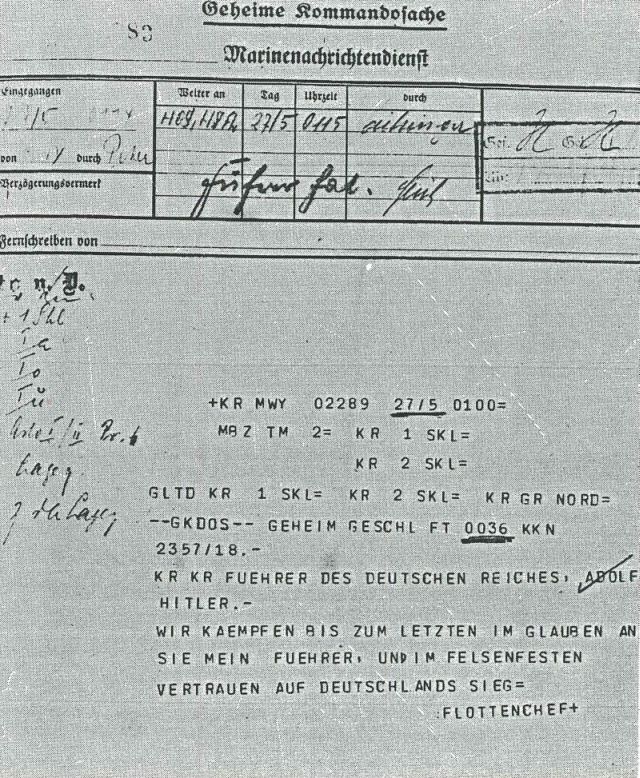
Lütjens' final report informing the German command of its intention to fight the enemy to the end
commons.wikimedia.org
Execution
At 8:47 the first shots were fired from Rodney's cannons, a minute later King George V began firing. Bismarck fired two minutes at the British ships and focused on Rodney, as his 406 mm cannons posed a greater danger than the 365 mm King George V cannon. The first two volleys of Bismarck were inaccurate, but the third landed close enough to the ship. At 8.59, Bismarck was hit for the first time.
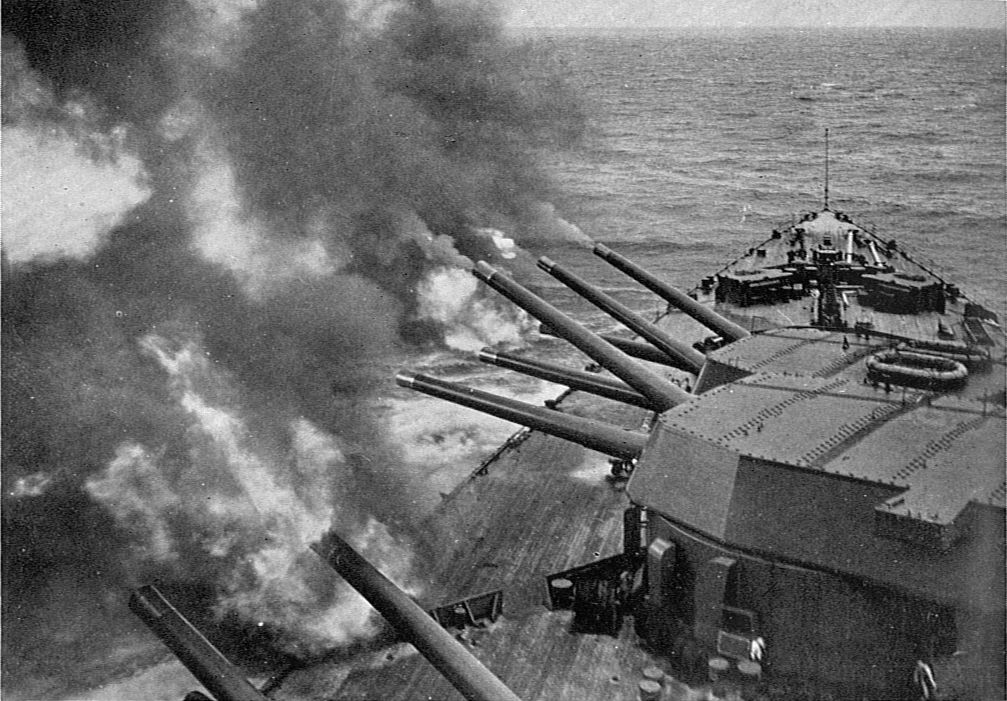
A volley of Rodney battleship guns
commons.wikimedia.org
King George V took advantage of the firing range at Rodney and approached Bismarck for 16,000 yards. At 9:05, Bismarck was hit a second time and at 9:09 a third time. The cruiser Norfolk approached from the north and also began firing at Bismarck. Bismarck was under fire from three British ships, his fire becoming inaccurate, as one of the first hits knocked out the center coordinating the firing of turrets.Then Bismarck received another hit, which hit the bridge and killed Admiral Lütjens.

Rodney shoots at a burning Bismarck in the distance
commons.wikimedia.org
From the south came the heavy cruiser Dorsetshire , which accompanied the convoy sailing to England. At 9:15, he began firing on Bismarck and Dorsetshire. King George V. and Rodney passed Bismarck, Rodney fired six torpedoes, but neither hit the target. British ships now had to zigzag around Bismarck because its speed was minimal, and they could not adjust its speed due to the presence of German submarines, which would serve as an easy target. Bismarck became a floating wreck that burned in many places. However, Captain Lindemann still did not give the order to leave the ship, the German war flag was still flying on the mast.
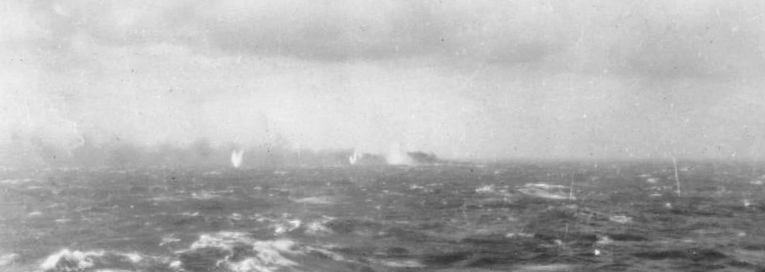
Burning and sinking Bismarck
commons.wikimedia.org
Admiral Tovey was getting nervous because Bismarck still didn't want to sink. Here the perfection of its construction was shown. Rodney approached Bismarck for 3,000 yards and fired two torpedoes, one hitting. Norfolk did the same and hit the target. Admiral Tovey decided that after two hours of battle, Bismarck would be executed, so at 10:15 he gave the order to return to England.
Although the two hours lasting "execution" 380 grenades fired from Rodney 406 mm, 356 mm shells 339 from King George V, 527 shells 203 mm of Norfolk, 254, shells 203 mm from Dorsetshire, 716 shells of 152 mm Rodney 660 133 mm grenades from King George V., the wreck of Bismarck still clung to the water. He was to be reached by Dorsetshire. At 10:20 he fired two torpedoes to the starboard side and one to the port side. Only now did Captain Lindemann order the ship to leave. At 10:36, Bismarck rolled to the right and disappeared into the depths of the Atlantic after a while. It was in the position 48 ° 09´ N 16 ° 0´7 W.
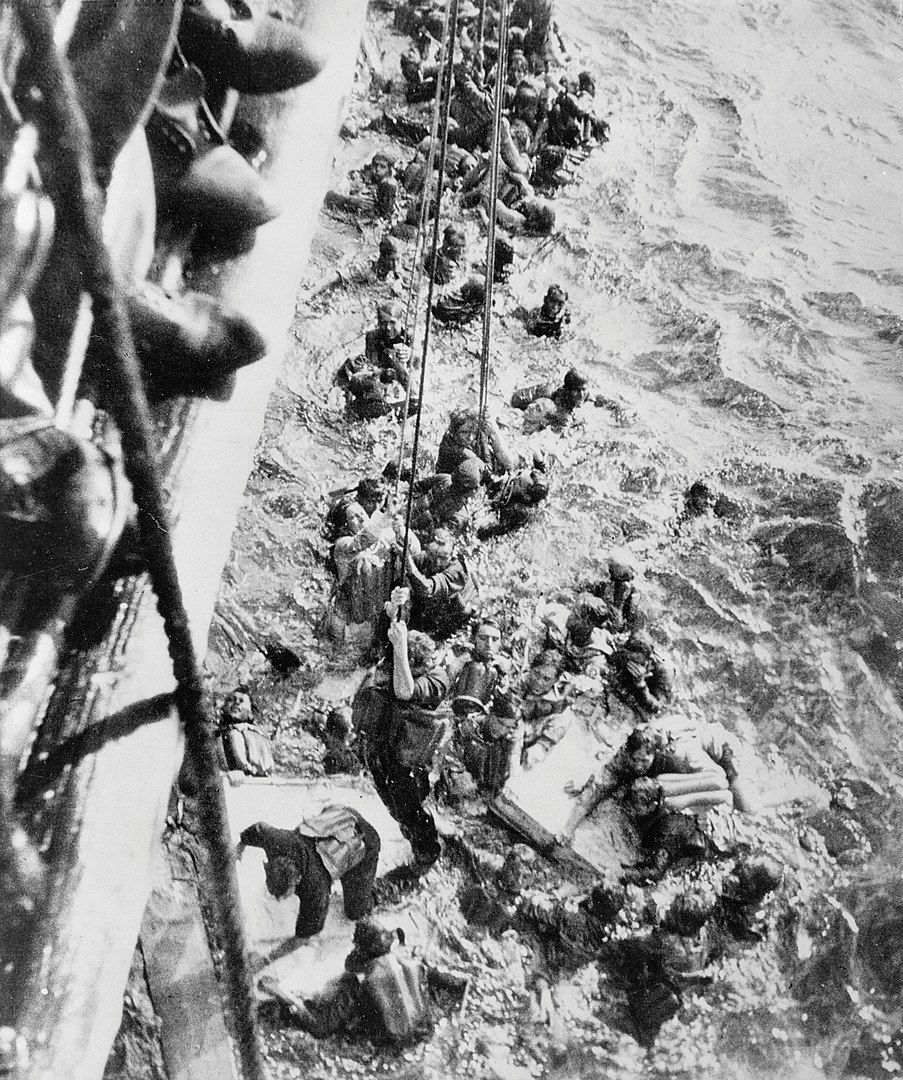
Sailors from Bismarck are hauling to Dorsetshire
commons.wikimedia.org
Of the crew of 2,400 men, only 117 men were rescued. A few days after the sinking of Bismarck, the British sank other ships involved in Operation Rheinübung. They were supply ships that Bismarck and Prinz Eugene could keep at sea for more than a year without having to sail to port. Prince Eugene arrived in Brest on June 1, where he remained until February 1942.
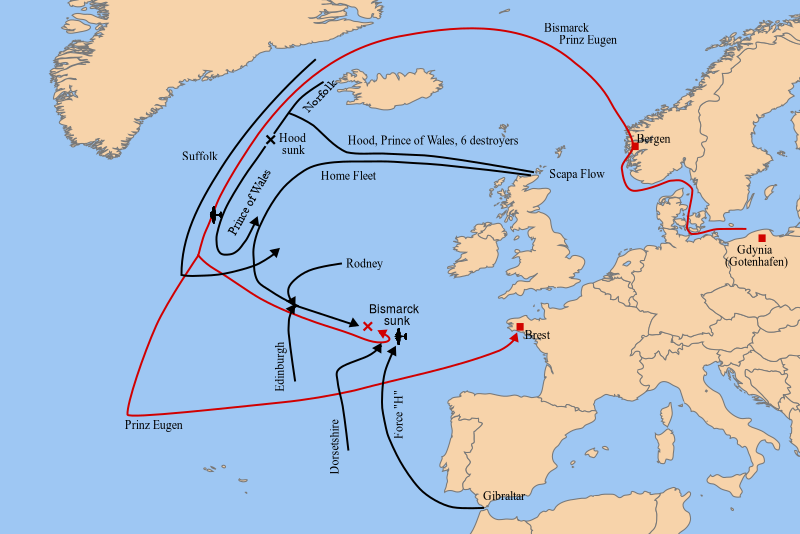
Map showing the movements of Prince Eugene, Bismarck and pursuing ships
commons.wikimedia.org
As the only large German ship, Prinz Eugen survived the war and was handed over to the Americans as spoils of war. They sank him during atomic weapons experiments in the Pacific Ocean. Bismarck was discovered on June 9, 1989 by an expedition by Robert Ballard at a depth of 4,700 meters about 400 miles from France.
King George V. performed many other tasks during the war, he was decommissioned in 1958.The Prince of Wales and Repulse were sunk east of Malaysia by Japanese aircraft from the 23rd Air Fleet. The Ark Royal was sunk east of Gibraltar by a U-81 submarine. Dorsetshire was sunk along with the heavy cruiser Cornwall southwest of Ceylon by aircraft of the 1st Air Force of Japan. Most of the other ships survived the war and were eventually scrapped.
Join us
We believe that there are people with different interests and experiences who could contribute their knowledge and ideas. If you love military history and have experience in historical research, writing articles, editing text, moderating, creating images, graphics or videos, or simply have a desire to contribute to our unique system, you can join us and help us create content that will be interesting and beneficial to other readers.
Find out more